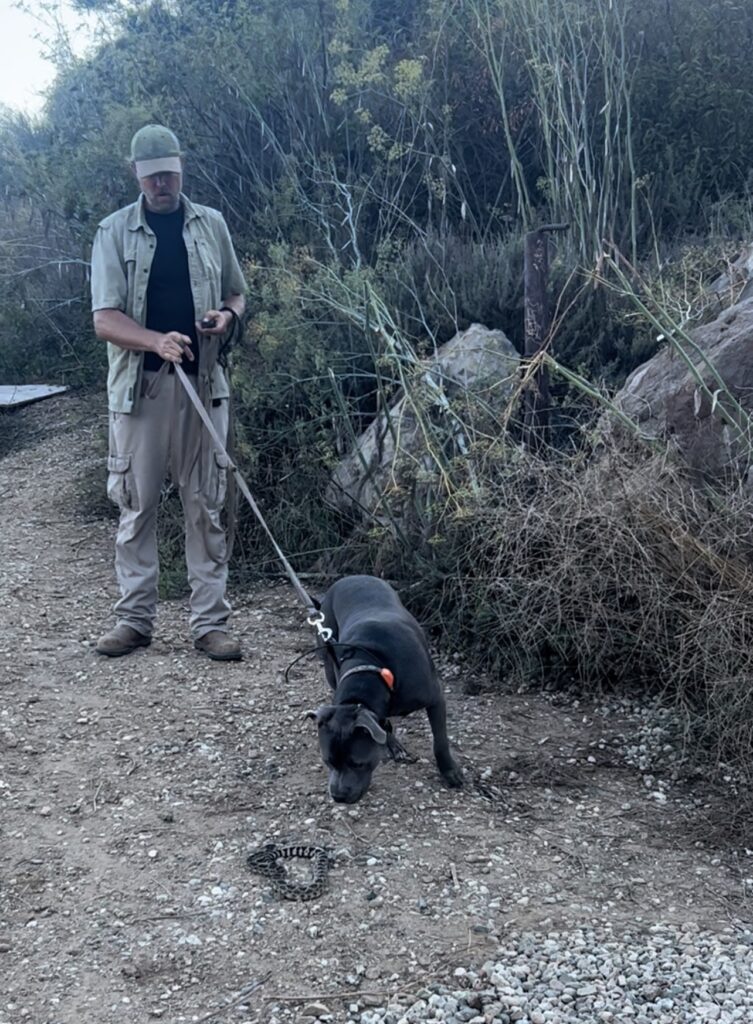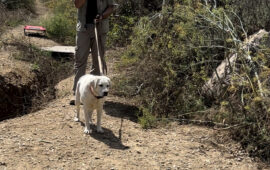Hi,
Like every year, I will be giving the option of rattlesnake aversion training with the pack. This training is entirely optional, and I will add details relevant to making a decision below.
I just received word back from the trainers that they will be available on Sunday, September 9/10, for the training this year, and we will likely be running two groups on this day. This email is to get an idea of how many clients will be interested in having their dog do the training, and I will plan to follow up with emails regarding scheduling, once I have the group lists set up. (If your dog has already done the training twice, that is likely enough for any dog for at least a couple of years, so please disregard this email.)
Some helpful background information:
I’ve been hiking with the dogs since 2011, and on average, we’ve run into about 2-3 rattlesnakes per year. Rattlesnake veterinary treatment is something that I do not pay for, (whereas if a dog was bitten by another dog I will almost always pay for that, as I consider that my responsibility.) There have been a few cases that may be beneficial to know about that I will talk about here.
2016 was the first year that a dog was bitten–he was walking behind me and I heard a yelp and saw him back away from a bush. As I went back I heard a rattle coming from the bush and two dots of blood on the dog’s lip, so we headed back right then and went to the vet. He stayed overnight and I believe it ended up being roughly $1,500. This dog was rattlesnake-trained before, but I believe that without the opportunity to see the snake, (it was hidden in the bushes), he did not recognize the threat.
In February of 2017, a dog was also bitten, this time in the rear foot, (an unusual place the vet said). This looked more like a hotspot, so the dog was not taken to the vet until the following day. This ended up costing about $4,000 to treat, because it had progressed and was treated so late. The aversion training likely would not have helped in this situation, and we don’t know exactly how this event happened.
In July of 2023, my brother’s dog was bitten. I give a good amount of freedom to the dogs on the private land, and I didn’t see the bite happen, so I’m not sure where or how it happened. He also wasn’t whining, or showing any sings of being bitten, and with his face down in the back of the van, sleeping, I didn’t notice the swelling until it was time to drop him off. Once I noticed the swelling, I got him to the vet within 30 minutes, and he began treatment shortly after. Because he began treatment likely close to 4 hours after being bitten, the venom had a good amount of time to take effect, and he required plasma injections, additional blood tests, and time at the vet, in addition to the anti-venom. They kept him for about 24 hours. He recovered well after that, and the treatment was expensive, likely due to the amount of time the venom had to act, as well as the increased cost of veterinary care in recent years, and it came out to $7,812. ( I had originally told owners over $9,000, because that was true, but I later received a refund for just over $1,500.) So, this was very expensive. I am now paying much more attention to dogs’ faces after the hike to check for swelling. He had not ever been rattlesnake trained, and was bitten on his upper lip.
Additional helpful information: I did once see my dog, who has gone through the rattlesnake training twice, jump about 3 feet back away from a bush and trot back to the group. When I went to check, a rattlesnake was slithering away. I have also seen dogs that have done the training jump away when smelling a dead, non-poisonous snake. So, there have been somewhat mixed results. Ultimately, I think that if a snake were visible, a dog that had done the training would be much more likely to keep a safe distance from it until I separated them than a dog who had not done the training.

Will a dog die?
Debbie Oliver, a vet in the Pacific Palisades, who has treated likely hundreds of cases of rattlesnake bites on dogs over her 15 years or so as a local, vet said that she has only had one die, because he was bitten directly in a vein. Based on that information, it seems that the likelihood of death is fairly low if a dog is bitten, but is a possibility, especially if not treated in a reasonable amount of time.
Prices:
The training will cost $80/dog for the business, and I will be charging $60 for coordinating and pick-up and drop-off. I will charge $50 per additional dog per household. ($60 for one dog, $110 for two. So, 1 dog trained = $140, 2 dogs = $270). We will also almost certainly be doing approximately an hour long hike either just before, or just after the training, to help the dogs burn off steam.
How the Training Process Works:
The training exposes the dog to a muzzled rattlesnake, a muzzled baby rattlesnake, a snakeskin, and the sound of a snake rattling, and each time, if the dog shows interest, he is shocked at a customized shock level. The dog is not forced to investigate any of the stimuli, but is given the option. The dogs usually want nothing to do with the snake by the end, and actively avoid it once they realize what it is.
The website of the company:
A video of the training:
Rattlesnake run-in 8/27/22
All in all, I would definitely recommend it for dogs with a higher prey drive. For dogs with a lower prey drive, I wouldn’t consider it a necessity, but, because they might still inadvertently not avoid a snake if it were on the trail, I personally would probably still have the training done. Of course, please feel free to contact the have the training done on your own if that can work better. (There is a $50 transportation fee charged by this company if less than 5 dogs are being trained.)
_______________
Additional Financial Protection-Pet Insurance:
Another great option for financial protection is pet insurance. It can be reasonably priced, and cover 70-90% of all veterinary costs. For example, Healthy Paw Pet Insurance I believe will insure a 4 year old Pit Bull for approximately $75/month, and that would cover up to 70% of an emergency veterinary visit. Please of course do your own research, as I’m sure prices will change. I will leave two reputable pet insurance companies below. (I have no affiliation.)
________________
Please let me know if you would like your dog to participate, or if you have any questions. Also, please allow me plenty of time to get back to you. Thank you for being part of the pack!
Thanks,
Colin

